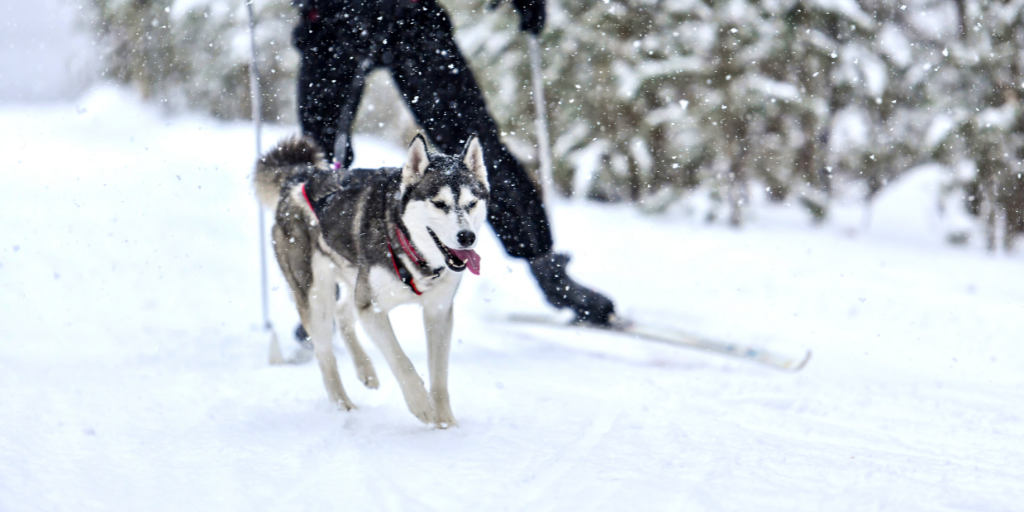But First, Keep Your Dog Safe Outside
Before we dive into outdoor winter activities, it's important to keep your dog safe. Here are necessary considerations to take before heading out with your pup:- Make sure your dog can handle the cold and snow. Some cold weather breeds were made for winter, others not so much.
- Keep your dog protected from winter elements with jackets, booties and other clothing.
- Don't stay out for long, even if your dog is wearing winter clothing. This is especially the case if the temperature is below freezing. Find out what temperatures are too cold for dogs, here.
- Cut your dogs nails and trim fur around the toes to avoid ice clumping and other damage.
- Bring treats or food to fuel your dog. They will use some energy to keep themselves warm, which means they'll lose energy more quickly than in other weather.
- Also bring water and bowls so your dog doesn't try to eat snow, which can contain chemicals, salt, dirt and more.
- Make sure your dog has up-to-date identification tags and microchipping in case of separation. For extra protection, consider using a GPS tracker.
- Use reflective gear and bright colors since it gets dark more quickly in winter and visibility can be low with snow, windy and rain.
- Senior dogs may not be suited for cold weather activities if they have joint issues, arthritis or other health issues.
- Always clean your dog’s paws and any part of their body that came in contact with winter elements to remove any chemicals.
Outdoor Activities
Walk It Off
Winter doesn't mean you can't go for walks, it just means you'll need to take some extra precautions. These include properly bundling up your pup in coats and other winter clothes, protecting their paws, keeping walks short and knowing what temperature is too cold. Read our article on water walk safety to find out more!
Take a Winter Hike
Similarly to walks, winter doesn't mean you can't still go hiking with your dog. In fact, winter hikes are a great way to get out in nature - an activity that has been shown to be a form of self-care with positive impacts. Plus, it switches up the scenery for your dog, giving them a chance to explore a whole new world of scents and sights. Just use the same precautions as you would with winter walks, plus extra ones for hiking safety specifically. Check out these hiking essentials to make the most of your trip!
Try Skijoring
If you have a larger, athletic dog who loves to run and you like skiing, then skijoring may be for you. Don't know what skijoring is? We didn't either. Skijoring is a mix of cross-country skiing and dog sledding. Basically you clip your skis to your dog's harness and glide along as your dog runs through the snow. Just make sure to have a quick release attachment in case you need to hastily detach from your dog. You can also add challenges for your dog with training commands, like turn and stop. Pro Tip: Pulling breeds (like Huskies, Newfoundlands and Samoyeds) will likely require forced breaks as they won't want to stop even when they're tired.
Play Fetch
Cold weather likely isn't enough to stop your dog from playing fetch if they love it. Snow can even add an extra challenge to the game by forcing your dog to search for the ball. Just make sure not to stay out for too long because of the risk of hypothermia and avoid icy areas to prevent your dog from slipping and injuring themselves. Pro Tip: Use a bright colored ball or one in colors dogs can see (such as yellow or blue) so it's easier for you both to find.Have a snowball fight
Snowball fights are a classic winter activity for humans, but you can also include your dog in them. Make sure to keep snowballs soft (in other words, don't pack them too hard) and toss them for your dog to chase or try to jump up and catch. Also, avoid letting your dog eat too much snow.
Practice Nose Work And Scent Tracking
Winter provides a great opportunity to practice nose work (when your dog uses their nose to locate something). This is because winter conditions - such as snow, wind and rain - can all affect scent flow, making it more challenging. If there's snow on the ground, you can hide treats, balls and other toys. It provides both physical and mental stimulation for dogs because it requires running around as well as problem-solving skills.Create a Snow Maze
One creative idea is to build a snow maze for your dog, which first became popular when owners shared videos to social media of the snow mazes they made for their pups. The maze will provide physical exercise as your dog navigates it, as well as mental stimulation as they problem solve to find their way out. To create your own, use a shovel to form narrow pathways that twist and turn. Pro Tip: Build your snow maze in a fenced area or use a long leash to avoid separating from your dog.Indoor Activities
Bake Goodies For Your Dog
Baking and winter are a match made in heaven, so why not make some heavenly homemade treats for your pup. You can spend some time making the goodies while your pup "helps" by your side. They'll be cutest sous chef there ever was!Go to an Indoor Dog Park
Some cities have indoor dog parks, which are exactly what they sound like. These large, climate-controlled facilities offer the same benefits of an outside dog park (playtime, socialization, etc.) with one advantage: you can go any time of the year. Some indoor dog parks even have restaurants and lounges for the owners. If your city doesn't have an indoor dog park, you can take your dog to doggie day care to romp around, play and get their energy out.
Snuggle Up In Front Of The TV
Though it won't help get your dog's energy out, watching TV with your dog can be the perfect winter activity for those days that are just too cold, wet or windy. Your dog will love the quality time spent together cuddling on the couch. And if you want to get your dog some mental stimulation, try putting on something they'll be interested in like programs with dogs and other animals, sports or action.Paint With Your Pup
Did you know that there are pet-safe paints and art sets that allow you and your pup to create some masterpieces? Well, maybe not masterpieces but they will let your dog's inner artist shine through. Just double check that you're using pet-safe paints and always wash their paws thoroughly when done.
Pro Tip: Put down a tarp under the canvas or paper so you can catch any paint mess that's bound to happen.


1 comment
Its like you read my mind! You seeem to know a lot about this,
like you wrote the book in it or something. I think that
youu can do with some pics to drive the message home a little bit, bbut other
than that, this is wonderful blog. A fantastic
read. I’ll certainpy be back. https://theslotsonline.Mystrikingly.com/